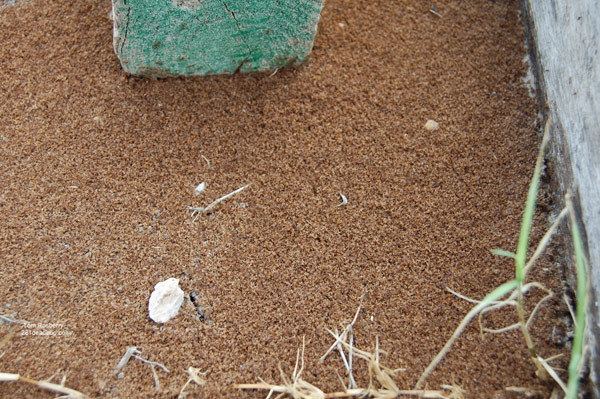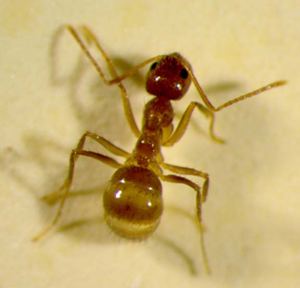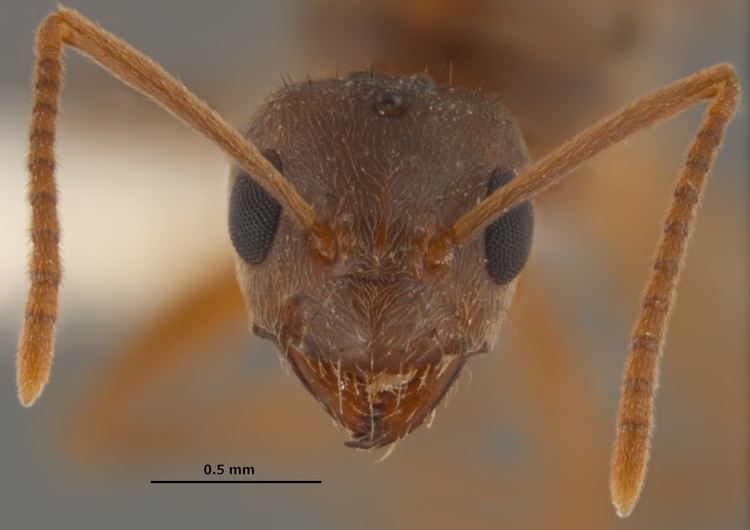Scientific name Nylanderia fulva Order Hymenopterans | Family Formicidae Genus Nylanderia Higher classification Nylanderia Rank Species | |
 | ||
Similar Yellow crazy ant, Nylanderia, Paratrechina, Fire ant, Longhorn crazy ant | ||
Rasberry crazy ants texas country reporter
The Rasberry crazy ant or tawny crazy ant, Nylanderia fulva, is an ant originating from South America. Like the longhorn crazy ant (Paratrechina longicornis), this species is called "crazy ant" because of its quick, erratic movements. It is also called the "Rasberry crazy ant" in Texas after the exterminator Tom Rasberry, who noticed that the ants were increasing in numbers in 2002. Scientists have had trouble identifying this ant as a species owing to confusion regarding the taxonomy of the genus, but it has now been identified as Nylanderia fulva.
Contents
- Rasberry crazy ants texas country reporter
- Fire ants vs rasberry crazy ants
- Description
- Formic acid as an antidote to fire ant venom
- Attraction to electrical equipment
- Rate of spread
- Range in the United States
- Control in the US
- References
In 2014, it was discovered that the ant produces and covers itself with formic acid as an antidote to the fire ant's venom. It is the first known example of an insect being able to neutralize another insect's venom, an ability speculated to have evolved in South America where the two species share the same native range. Colonies have multiple queens, which also contributes to their survival.

As of 2012, the ants have established colonies in all states of the Gulf Coast of the United States including at least 27 counties in Southeast Texas.

Fire ants vs rasberry crazy ants
Description
The ant is about 0.125 in (3.2 mm) long, thus smaller than the red imported fire ant, Solenopsis invicta. It is covered with reddish-brown hairs. The colonies live under stones or piles; they have no centralized nests, beds, or mounds. They tend aphids for honeydew, feed on small insects and vertebrates, and forage on plants, especially for sweet materials. The ants appear to prefer the warmth and moisture of the coast.
N. fulva has been a pest in rural and urban areas of Colombia, South America, where it displaced all other ant species. There, small poultry such as chickens, have died of asphyxiation, while larger animals, such as cattle, have been attacked around the eyes, nostrils, and hooves. Grasslands have dried out because of the increase in plant-sucking insect pests (hemipterans), which the ants cultivate to feed on the sugary "honeydew" that they excrete.
When attacked, these ant, like other formicine ants, can bite but not sting, and excrete formic acid through a hairy circle or acidopore on the end of the abdomen, using it as a venom, which causes a minute pain that quickly fades. Formic acid was named after the Latin word formica (ant), because it was first distilled from ants in the 17th century. Uniquely, the tawny ant also uses formic acid as an antidote against the venom of the fire ant.
Tawny crazy ants were found to displace other ant species in their native Argentina and later the US, including the red imported fire ant. This was first thought to be due to exploitative and interference competition.
Formic acid as an antidote to fire ant venom
In March 2014, researchers concluded that formic acid helped tawny crazy ants survive the fire ant venom 98% of the time; when the gland ducts were blocked with nail polish in an experiment, crazy ants had only a 48% chance of surviving fire ant fights. After exposure to fire ant venom, N. fulva retreats, covers itself with formic acid and returns to the fight. This is the first known example of an insect detoxifying another insect's venom, and the first discovery of an ionic liquid in nature which results from mixing of formic acid with venom from S. invicta.
How formic acid acts as an antidote against the much more toxic fire ant's venom is unknown. Fire ant venom is a mixture of toxic alkaloids and proteins that presumably enable the alkaloids to enter rival ants’ cells. Each alkaloid in the fire ant’s venom, including solenopsin, has a six-membered heterocyclic ring with fat-soluble side chains. The researchers who discovered the antidote property of formic acid in crazy ants speculate that the formic acid denatures the proteins in fire ant venom. Another possibility is that the nitrogen on an alkaloid’s heterocyclic ring is protonated, rendering the ionic molecule less lipophilic, thus less likely to penetrate the tawny crazy ant’s cells.
Attraction to electrical equipment
Infestations of Nylanderia fulva in electrical equipment can cause short circuits, sometimes because the ants chew through insulation. Overheating, corrosion, and mechanical failures also result from accumulations of dead ants and nest detritus in electrical devices. If an ant is electrocuted, it can release an alarm pheromone in dying, which causes other ants to rush over and search for attackers. If a large enough number of ants collects, it may short out systems.
It is unclear why colonies of Nylanderia fulva, like many species of ants, are attracted to electrical equipment. They may sense the magnetic fields that surround wires conducting electric current, or they prefer the warmth produced by resistance to the currents in the wires. Some argue they simply are searching for food or an attractive place to nest.
Rate of spread
The Texas A&M University research extension service quotes the annual rate of spread by ground migration as about 240 and 360 m per year in neighborhoods and industrial areas, respectively, and 207 m/year in rural landscapes hence spreading more slowly than fire ants. Other sources quote 800 m (0.50 mi) per year. Being carried by people, animals, and vehicles (in trash for example), the observed rate is much higher: the spread from five Texas counties in 2002 to 20 in 2007 yields an accelerated rate of 8 km (5.0 mi) per year, at which rate it would take about 70 years for them to reach New Orleans. However, in 2011, tawny crazy ants were reported in Mississippi, in August 2012 in Port Allen, Louisiana, and in 2013 in Georgia.
Range in the United States
The earliest record of N. fulva presence in the US is from Brownsville, Texas, in 1938. By the early 2000s, the ants spread across the southeastern portion of Texas including at least 27 counties Large population explosions have been described also on St Croix in the US Virgin Islands; in many cases the ant species was misidentified as its close relative, the hairy crazy ant, Nylanderia pubens. As of 2012, the ants have established colonies in all states of the Gulf Coast of the United States. The ant is considered an invasive species.
Control in the US
The ants are not attracted to ordinary ant baits, and are not controlled by over-the-counter pesticides, and are harder to fully exterminate than many other species because their colonies have multiple queens. In June 2008, the United States Environmental Protection Agency granted temporary approval for the use of fipronil, an antitermite agent, to control this ant. Its use is currently restricted to 27 counties.
